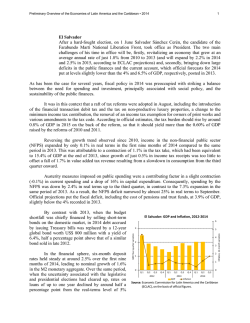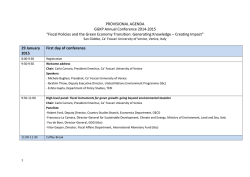
Fiscal Panorama
Executive Summary Fiscal Panorama of Latin America and the Caribbean 2015 Policy space and dilemmas Executive Summary Fiscal Panorama of Latin America and the Caribbean 2015 Policy space and dilemmas Alicia Bárcena Executive Secretary Antonio Prado Deputy Executive Secretary Daniel Titelman Chief, Economic Development Division Ricardo Pérez Chief, Publications and Web Services Division The Fiscal Panorama of Latin America and the Caribbean. Executive Summary is the English-language summary of the full version of the report prepared each year by the Economic Development Division of the Economic Commission for Latin America and the Caribbean (ECLAC). Daniel Titelman, Chief of the Division, and Ricardo Martner, Chief of the Division’s Fiscal Affairs Unit, were responsible for the coordination of the 2015 edition. The German Agency for International Cooperation (GIZ) and the Spanish Agency for International Development Cooperation (AECID) assisted with the financing of this publication. LC/L.3962 • March 2015 • 15-00110 © United Nations • Printed in Santiago, Chile Contents Executive summary...............................................................................................5 A. Public debt levels are low in Latin America and high in the Caribbean............................. 5 B. Overall, the region has enough fiscal space to apply countercyclical policies and boost production development............................................................. 7 C. The fiscal management of non-renewable natural resources needs to be modernized........... 8 D. Fiscal policy has a very limited impact on the distribution of disposable income................. 9 E. In a volatile macroeconomic environment, reforms should aim to strengthen personal income tax...................................................................... 10 3 Executive summary A. Public debt levels are low in Latin America and high in the Caribbean Beyond the cyclical fluctuations in the deficit or other flow variables, the sustainability of fiscal policies is unquestionably bound up with the level, make-up and maturity profile of public debt. A long-term overview shows that Latin America, taking the average of 19 countries, experienced a lengthy period in which public debt rose as a proportion of GDP (between 1970 and 1989), followed by phases of contraction between 1990-1997 and 2004-2008, brief expansion between 1998 and 2003 and, lastly, stabilization between 2009 and 2014 (see figure 1). Figure 1 Latin America:a external and domestic public debt, simple average, 1970-2014 b c (Percentages of GDP) 100 90 80 70 60 50 40 30 20 External debt 2012 2014 d 2010 2008 2006 2004 2002 1998 1996 1994 1992 1990 1988 1986 1984 1982 1980 1978 1976 1974 1972 1970 0 2000 10 Domestic plus external debt Source:Economic Commission for Latin America and the Caribbean (ECLAC) and World Bank Data. a Simple average for 19 countries: Argentina, Bolivarian Republic of Venezuela, Brazil, Chile, Colombia, Costa Rica, Dominican Republic, Ecuador, El Salvador, Guatemala, Haiti, Honduras, Mexico, Nicaragua, Panama, Paraguay, Peru, Plurinational State of Bolivia and Uruguay. b Data on domestic public debt refer to 1990-2014. c Non-financial public sector. d Data for 2014 refer to the third quarter. During the economic boom years —between 2003 and 2008— public debt came down and its make-up changed significantly, shifting towards longer maturities, a higher percentage of fixedrate debt, a greater share held by residents and a larger portion denominated in local currency. Accordingly, the past 25 years have seen the external public debt fall dramatically in the region, from slightly over 70% of GDP in the early 1990s to 16% of GDP in 2014. Between 2000 and 2014, in the 19 Latin American countries included in the study, public debt came down as a proportion of GDP in 11, rose in 5 (Chile, Dominican Republic, El Salvador, Mexico and Uruguay) and held more or less constant in 3 (Bolivarian Republic of Venezuela, Costa Rica and Guatemala) (see figure 2). 5 Figure 2 Latin America (19 countries): public debt by country, 2000 and 2014 (Percentages of GDP) 90 80 70 62 60 50 46 44 40 43 40 42 38 36 36 39 30 30 30 29 26 30 24 22 20 19 18 Peru Paraguay Chile Ecuador Guatemala Nicaragua Haiti Venezuela (Bol. Rep. of) Bolivia (Plur. State. of) 2014 Panama Mexico Honduras Dominican Rep. Argentina Costa Rica Uruguay Colombia Brazil 0 El Salvador 10 2000 Source:Economic Commission for Latin America and the Caribbean (ECLAC), on the basis of official figures. Debt levels vary greatly between countries. Brazil has the highest public-debt-to-GDP ratio in Latin America, at 62% in 2014, although its net debt is much lower, as was noted in the previous edition of Fiscal Panorama1 and as recorded in the statistical annex of this edition (available online). Other countries in South America (Argentina, Colombia and Uruguay), some Central American countries (Costa Rica, Dominican Republic, El Salvador, Honduras and Panama) and Mexico have modest debt levels of between 36% and 46% of GDP. At the other end of the spectrum are Chile, Paraguay and Peru, whose public debts are below 22% of GDP, and even lower when considered in net terms. In the wake of the international financial crisis of 2008-2009, the average public debt of the 19 Latin American countries held steady at about 34.4% of GDP in 2014. However, the Dominican Republic, some Central American countries such as Costa Rica and Honduras, as well as Chile, Ecuador and Mexico, recorded an uptrend in their gross public debt as a percentage of GDP. Among Caribbean countries, the average public-debt-to-GDP ratio was significantly higher, at about 80% in 2014. Distinguishing by economic specialization, Caribbean exporters of services (mainly tourism and financial services) posted a higher average public-debt-to-GDP ratio (88%) than exporters of raw materials (minerals and hydrocarbons) (56.5%), according to 2014 figures. Moreover, the public debt of tourism-reliant countries has risen in the past 15 years, while that of the raw-material exporting economies has reverted, after some fluctuations, towards the levels recorded in the early 2000s. Comparing data for 2000 with the most recent available shows that only five Caribbean countries —Antigua and Barbuda, Dominica, Guyana, Saint Kitts and Nevis and Suriname— were able to lower their public-debt-to-GDP ratios in this period (see figure 3). Guyana, a beneficiary of the Highly Indebted Poor Countries (HIPC) Initiative, was the country that most reduced its 1 6 See ECLAC, Panorama Fiscal de América Latina y el Caribe: hacia una mayor calidad de las finanzas públicas (LC/L.3766), Santiago, Chile, January 2014. debt levels, from 120% of GDP in 2000 to 61% in 2014. However, public debt levels increased to varying extents in another eight countries. For example, in Barbados, one of the least indebted countries in 2000, public debt amounted to 98% of GDP in 2014 —exceeded only by Jamaica’s rate of 128% that year. Several countries have signed debt restructuring agreements with the International Monetary Fund (IMF), or have announced broad fiscal reforms which, coupled with the potential recovery of the Caribbean economies, could gradually reduce debt levels. Figure 3 The Caribbean (13 countries): public debt by country, 2000 and 2014 (Percentages of GDP) 200 180 160 128 120 98 100 96 80 95 90 80 76 72 72 63 60 62 61 40 31 Guyana The Bahamas Trinidad and Tobago Saint Vincent and the Grenadines Belize Dominica Grenada 2014 Saint Lucia Antigua and Barbuda Saint Kitts and Nevis Jamaica 0 Barbados 20 Suriname 140 2000 Source: Economic Commission for Latin America and the Caribbean (ECLAC), on the basis of official figures. B. Overall, the region has enough fiscal space to apply countercyclical policies and boost production development Fiscal space is typically defined as the availability of resources for a specific purpose that does not impair the sustainability of the government’s financial position or of the economy as a whole. While the concept is clear, it is more difficult to estimate the magnitude of fiscal space when the purpose is to prepare a countercyclical stimulus package, for example. According to an indicator of public debt sustainability, consisting of a common debt standard or rule, most Latin American countries will have some available fiscal space for 2015. In addition, the analysis presented in this study found that only two of the region’s economies faced fiscal tension in 2014. However, many countries are witnessing a deterioration of flow variables (especially fiscal deficits) as a result of macroeconomic headwinds. Countries with low public debt are taking advantage of this fiscal space to address the slowing economy with efforts to boost public and private investment. This makes sense insofar as publicly funded investment projects can boost output in both the short and long terms without increasing the debt-to-GDP ratio, especially in periods when the economy has idle capacity and clearly identified infrastructure requirements, as is the case in the region. 7 In countries with higher levels of public debt or financing difficulties, the weaker public accounts forecast for 2015 have prompted announcements of budget cuts. Spending containment measures should take into account the need to protect investment and avoid vicious circles whereby fiscal overadjustments strangle growth and tax revenues, ultimately widening the deficit and increasing the public debt burden. The region has made good progress on countercyclical policies aimed at smoothing public revenue flows in the event of cyclical changes in their sources. At the same time, the countercyclical architecture needs to include mechanisms to ensure that investment —as an increasingly key variable of economic performance and growth— can be financed at the different phases of the cycle. Strengthening the investment component not only helps mobilize domestic demand in the short term and promote growth, but is also the main bridge between the challenges of the economic cycle and medium- and long-term growth and development. In this context, development macroeconomics should aim not only to smooth economic cycles, but also to enhance production development and structural change by protecting investment growth over time. C. The fiscal management of non-renewable natural resources needs to be modernized Non-renewable natural resources have made a key contribution to Latin America’s strong macroeconomic performance over the past decade, and as such their fiscal management has become a focus for renewed interest in most of the region’s countries, including those with an established tradition of producing and exporting hydrocarbons and minerals, as well as those in which the extractive sector is in its infancy with potential for future development. The plunge in crude oil prices (and in the prices of certain minerals, such as copper) presents something of a challenge for the region’s commodity producers, owing to its impact on the external sector and its fiscal implications, notably the erosion of export earnings and government revenues. However, oil-importing countries have reaped the fiscal benefits of the recent price falls. Fiscal revenues from hydrocarbons slipped from 7.8% of GDP in 2013 to 6.7% of GDP in 2014, on average for the seven countries studied (see figure 4). In the Bolivarian Republic of Venezuela, Ecuador, Mexico and the Plurinational State of Bolivia, the effect of falling prices was compounded by sluggish growth, or indeed contraction, in output. In Colombia and Peru, hydrocarbons revenues will likely shrink as a proportion of GDP, despite increased crude oil and natural gas production. At current prices, a rough estimate suggests that these fiscal revenues will drop below 5% of GDP in 2015, on average for the seven countries studied. Conversely, revenues from mining held steady as a percentage of GDP in 2014, given that the decline in prices commenced in 2011. This is also a reflection of the fact that the sector’s income tax contribution has fallen to pre-boom levels. Non-tax revenues, largely in the form of royalties, have remained stable at about 0.2% of GDP on average. In 2015, the net result of factors such as lower prices, increased output and exchange-rate depreciation should be to stabilize fiscal revenues from mining at the already modest levels of 2014. 8 Figure 4 Latin America: fiscal revenues from non-renewable natural resources, by country groupings based on raw material exports, 2000-2014 (Percentages of GDP) 9 8 7 6 5 4 3 2 2014 a 2013 2012 2011 2010 2009 2008 2007 2006 2005 2004 2003 2002 2001 0 2000 1 Minerals and metals (6 countries) b Hydrocarbons (7 countries) c –2014 a Source:Economic Commission for Latin America and the Caribbean (ECLAC), on the basis of official figures. a The data for 2014 are taken from government forecasts or ECLAC estimates based on commodity price and nominal exchange-rate forecasts, assuming that output remains constant. Commodity price forecasts were taken from the Economist Intelligence Unit (EIU) and the International Monetary Fund (IMF); nominal exchange-rate forecasts from national budgets, and nominal GDP forecasts from ECLAC. b Brazil, Chile, Colombia, Mexico, Peru and Plurinational State of Bolivia. c Bolivarian Republic of Venezuela, Brazil, Colombia, Ecuador, Mexico (including revenues from Petróleos Mexicanos, PEMEX), Peru and Plurinational State of Bolivia. In the light of the current global context and the possible continuation of the downtrend in international prices observed since mid-2014, there seems to be a need to adjust, or at least review, the design of fiscal regimes. Much emphasis has been laid on the importance of effective instruments, not only to avoid distorting private investment and production decisions, but also to facilitate more progressive fiscal regimes in terms of the government’s take in periods of high prices. The reform of extractive industry tax regimes, especially in those countries of the region that rely heavily on non-renewable natural resource revenues, should therefore aim to combine instruments that ensure a relatively stable flow of fiscal revenues through the appropriation of rents from these sectors, while helping to create the right conditions for investment during different phases of the business cycle, based on the long-term stability of the legal and institutional framework. In any case, the fiscal sustainability of these countries will depend on their ability to offset declining tax revenues, at least partly, through reforms to strengthen those taxes that are unaffected by the price volatility of a small number of commodities. D. Fiscal policy has a very limited impact on the distribution of disposable income Beyond cyclical considerations, the region faces a further, chronic problem: inequality. Despite recent progress, Latin America remains the world region with the highest income concentration. The role of fiscal policy must therefore be assessed, with a view to proposing reforms to make countries’ tax systems and spending programmes more redistributive and more transparent. 9 The findings of this edition of Fiscal Panorama show that in Latin America, market income (i.e. income before direct taxes and transfers) is only slightly more unequal, on average, than in the countries of the Organization for Economic Co-operation and Development (OECD). However, the region’s tax systems and public social spending are less effective at improving the distribution of disposable income. On average for the region, the Gini coefficient falls by just three percentage points as a result of direct fiscal measures, and by a further six through State provision of education and health services. In European and other OECD economies, however, the combined redistributive impact of cash transfers and personal income tax amounts to 17-19 percentage points of the Gini coefficient on average, while redistribution through public expenditure in kind stands at between 6 and 7 percentage points. In countries with greater market income inequality, fiscal policy should perform a stronger redistributive role. Two groups of countries may be distinguished in this regard (see figure 5). The first (including Argentina, Brazil, Chile, Colombia, Costa Rica and Panama) consists in countries which have a market income Gini coefficient higher than the regional average and correct this greater inequality more effectively through fiscal policy than other countries.The second group (including the Dominican Republic, Honduras and Paraguay) also shows significant market income inequality, but in these countries fiscal policy plays a less active role in redistributing income. Figure 5 Latin America (16 countries): inequality reduction by fiscal policy instruments, around 2011 (Percentage points of the Gini coefficient) 16.4 14.8 13.6 12.1 11.9 11.8 8.5 9.1 Other cash transfers Education spending Health spending Paraguay Latin America and the Caribbean a 5.3 5.0 Nicaragua Honduras Dominican Rep. 6.0 5.8 5.8 5.6 Ecuador Peru Bolivia (Plur. State of) Public pensions Personal income tax and social security contributions Colombia Mexico Panama Chile Uruguay Costa Rica Brazil 7.0 6.9 El Salvador 9.9 Argentina 17 16 15 14 13 12 11 10 9 8 7 6 5 4 3 2 1 0 -1 Source:Economic Commission for Latin America and the Caribbean (ECLAC), on the basis of household surveys conducted in the respective countries. a Simple average. E. In a volatile macroeconomic environment, reforms should aim to strengthen personal income tax A hallmark of inequality in the region is the high proportion of total income that goes to the top decile, or the wealthiest 10% of households. On average, this group receives 32% of total income, although the figure varies widely from one country to the next. This situation is clearly illustrative of systems’ inability to tax the income of the most affluent sections of the population. 10 While the region’s tax systems are designed to be progressive, with marginal personal income tax rates between 25% and 40% for the highest income brackets, the rates actually paid by the top decile are very low as a result of evasion, avoidance, exemptions and deductions, as well as the preferential treatment of capital income, which in some countries is taxed at a lower rate than labour income and in others not at all. Consequently, the redistributive impact of income tax is severely limited, as can be seen by comparing average tax rates (defined as the ratio of tax paid to gross income) against their impact on the Gini coefficient (see figure 6). Figure 6 Latin America (16 countries): average personal income tax rate paid by individuals in the tenth decile and income redistribution, around 2011 12 10 2.0 8 1.5 6 1.0 4 0.5 Change in the Gini coefficient Paraguay Ecuador Venezuela (Bol. Rep. of) Honduras Colombia Dominican Rep. Nicaragua El Salvador Peru Costa Rica Brazil Chile Panama Uruguay 2 Mexico 0.0 Average income tax rate 2.5 Argentina Percentage points of the Gini coefficient (Percentage points of the Gini coefficient and percentages) 0 Average income tax rate of the tenth decile Source:Economic Commission for Latin America and the Caribbean (ECLAC), on the basis of household surveys conducted in the respective countries. On average, personal income tax causes the Gini coefficient to fall by 2% (or by 1 percentage point of the Gini coefficient, in absolute terms), with some differences between countries. As has been reiterated in numerous reports and forums, the weakness of income tax is the main structural problem facing the tax systems of Latin America. Tax policies have prioritized efficiency in the hope that personal income tax would have the smallest possible impact on savings and investment decisions and, in some cases, the tax base has shifted towards consumption instead of the traditional income base. This path has sacrificed fairness and simplicity; the main flaw undermining the income tax fairness is the asymmetry between the preferential treatment of capital income on the one hand, and the taxation of labour income on the other. In recent years, several of the region’s countries have implemented tax reforms that sought to generate higher revenues by raising tax rates, cutting exemptions, applying dual income taxation systems, creating or modifying minimum taxes, and stepping up oversight of large taxpayers. Although various changes have been made, one of the most notable developments with respect to previous decades has been the focus on personal income tax, not just to improve collection but also to strengthen one of the weakest points of fiscal policy in the region: the impact of tax systems on income distribution. The reforms have addressed different aspects 11 of tax design, including the modification of the tax base (in particular, so as to increase the taxation of capital income), tax rates and international tax rules. The Bolivarian Republic of Venezuela, Chile, Colombia, Ecuador, Honduras and Peru all implemented reforms in 2014. Simulations of potential reforms to personal income tax, based on household survey data, show that there is space for enhancing the redistributive function of this tax. If the tax rate effectively paid by the top decile was to rise to 20%, the redistributive impact of personal income tax would increase significantly in the region. This study shows that redistributing these improved tax revenues among the lower income deciles would have a major impact on the Gini coefficient and would triple the redistributive impact of fiscal policy. The evaluation of the redistributive impact of potential reforms underscores the importance of promoting initiatives to combat tax avoidance and evasion (especially with respect to personal income tax); treating capital income similarly to labour income; reducing preferential treatment; and lowering the income threshold for the highest tax rate, in keeping with tax bands established in other regions. 12
© Copyright 2026







